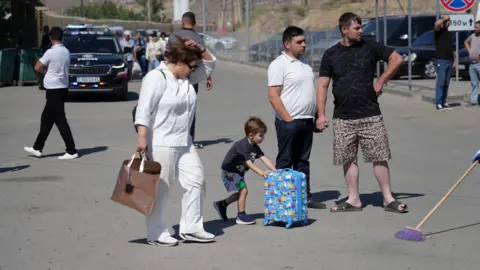The Agarak border crossing between Armenia and Iran has recently become a critical transit point for many Iranians fleeing escalating tensions and conflict in their homeland. As violence between Israel and Iran intensifies, families are heading toward safety in Armenia. This article captures the harrowing experiences of these individuals caught in a tumultuous situation.
The landscape at the Agarak border crossing is described as hot, dusty, and desolate, characterized by dry, rocky mountains devoid of shade. Such an inhospitable environment is not conducive to the weary travelers arriving from Iran. Among them is a woman holding a baby, while her husband negotiates with taxi drivers, and another family with a young child returning to their country of residence, Austria. What stands out is that most crossing the border hold residency or citizenship in other countries, emphasizing that they are not merely tourists but individuals seeking refuge from the ongoing conflict.
The source of the conflict stretches back to the attacks initiated by Israel on June 13, which targeted Iranian nuclear and military facilities as well as populated areas. As reported by the Human Rights Activists News Agency (HRANA), the devastation has resulted in the deaths of 657 people, with Iran retaliating against Israel, causing additional casualties. The fear among the Iranian populace has become palpable, as evidenced by the words of a father who described seeing the aftermath of a bombing. He expressed a collective state of fear, stating, “All the people are scared, every place is dangerous, it’s not normal.”
As chaos spirals in Iran, many residents of Tehran, a city with a population of ten million, are desperately seeking an escape, resulting in heavy traffic jams on roads leading out of the city. Reports from those who undertook the grueling journey from Tehran to Agarak indicate that the drive takes a minimum of 12 hours. Travelers recounted hearing the distant sounds of explosions from Israeli airstrikes but not witnessing the attacks firsthand. One young Afghan man, carrying only a suitcase, detailed how escaping Tehran was an arduous endeavor due to the lack of flights or alternative means of transport. He characterized the situation in Tehran as dire, filled with nightly attacks that prevent residents from sleeping due to constant fear.
Stories from refugees convey a painful sense of loss and confusion about the ongoing conflict. A young woman, returning to Australia, alluded to witnessing horrific events and expressed her struggle to process the trauma she experienced. The conflict’s international implications have also been discussed, with Israeli ministers suggesting that the unrest could lead to a regime collapse in Iran. Contrarily, a man named Javad, returning to Germany after a stay in Sabzevar, dismissed these claims, asserting that Israel is viewed as an enemy rather than a potential liberator.
While the majority of narratives at the border reflect a desire to flee and seek safety, there are individuals like Ali Ansaye, who is traveling back to Tehran after a holiday in Armenia. He expressed a defiant stance, indicating that he fears not for his own life and prefers to die in his homeland rather than succumb to the pressures of fear.
The situation at the Agarak border reflects a wider geopolitical crisis that has reverberations across the Middle East. As families grapple with fear and uncertainty, the plight of these individuals sheds light on the human cost of conflict, where many seek solace in the face of violence and instability. It highlights the necessity for diplomatic resolution, as countless lives are affected by decisions made far beyond their control. The experiences of those crossing borders point to a larger narrative woven with themes of fear, resistance, and the quest for a peaceful existence amidst chaos.



